Recovery and Restructuring Part II: The Indiana Economy Since 2001
This is the second of two articles reporting on the trends in economic growth, employment and income for Indiana, Indiana's Midwestern neighbors, and the country as a whole. Data released earlier this year by the Commerce Department presents a picture of several economic transitions. Last month's article, for example, showed that economic output, or gross domestic product, has been gradually shifting from vehicle manufacturing to manufacturing related to the life sciences. Last month's article also showed that employment can decline even while economic output is increasing, as has been the case for manufacturing in Indiana and almost all other states.
This article tracks changes in employment by industry and compares how Indiana's employment growth and income growth stack up with the rest of the country from 2001 to 2005. This time period was chosen because 2001 was the nadir of the economic cycle; 2005 is the latest year for which all data are available.
Between 2001 and 2005, U.S. employment grew by 1.1 percent at an average annual rate. With the exception of Tennessee, employment growth for Midwestern states has lagged behind the U.S. average (see Figure 1). Indiana's employment growth also falls below the Midwestern average. (The Midwestern average was pulled down by lackluster growth in Illinois and Ohio, as well as job losses in Michigan over the period.)
Figure 1: Employment Growth in the Midwest, 2001 to 2005

An InContext article in June by Morton Marcus made use of the same average earnings per job data presented in Figure 2, but this graph is presented for comparing with Figure 1. As one can see, Figure 2 places Indiana in a slightly more positive light than Figure 1. In terms of average earnings per job, Indiana's average earnings per job increased at a faster rate than the U.S. average and a majority of Midwestern states. That said, average earnings per job in Indiana falls below the national average by more than $5,200 a year. Illinois and Michigan are the only Midwestern states that exceed the national average earnings per job, by over $5,000 and over $2,000, respectively. The majority of the Midwestern states are huddled around Indiana, with average earnings per job in the low $40,000s.
Figure 2: Growth in Average Annual Earnings per Job in the Midwest and United States, 2001 to 2005
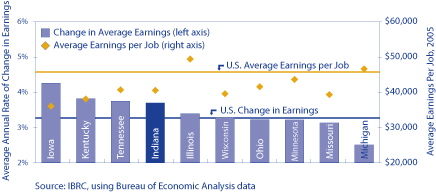
Click for larger imageFigure 3 shows why the Midwest in general and the states of Michigan, Ohio and Illinois in particular, have had such disappointing job growth. Michigan, Ohio and Illinois were hard hit in both the rate of job loss as well as in absolute numbers in the manufacturing sector. Michigan, for example, lost over 125,000 jobs from 2001 to 2005 in durable goods manufacturing. The loss of jobs in nondurable goods was not as dramatic.
Figure 3: Durable and Nondurable Goods Manufacturing Employment in the Midwest, 2001 to 2005

Click for larger imageFrom the perspective of changes in manufacturing employment, Indiana has been doing better than both the Midwest and the nation. Only three states had an increase in manufacturing jobs from 2001 to 2005. Indiana is in the group with moderate job loss in manufacturing (see Figure 4). As presented in Table 1, not all manufacturing industries in Indiana lost jobs, and those minor increases in employment somewhat offset the large employment losses. Given the frequent news reports of plant closings in Indiana, it may come as a surprise that motor vehicle manufacturing employment increased from 2001 to 2005, albeit by less than 1,000 jobs.
Figure 4: Manufacturing Employment Change, 2001 to 2005
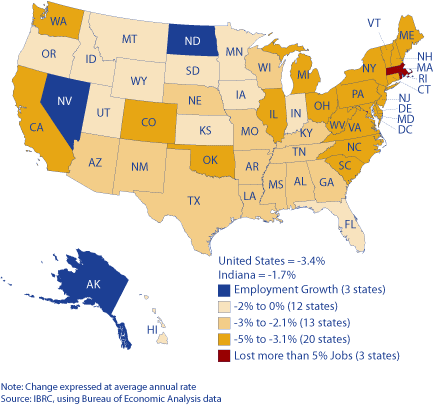
Table 1: Greatest Change in Jobs in the Manufacturing Industry, 2001 to 2005
| Manufacturing Industry | Change from 2001 to 2005 |
|
| Numeric | Average Annual Rate | |
| Top Five with Growth | ||
| Miscellaneous Manufacturing | 1,765 | 1.4% |
| Motor Vehicles, Bodies, Trailers and Parts | 924 | 0.2% |
| Food Manufacturing | 716 | 0.5% |
| Chemical Manufacturing | 601 | 0.5% |
| Beverage and Tobacco Products | 276 | 1.8% |
| Ten with Greatest Employment Loss | ||
| Furniture and Related Products | -1,306 | -1.1% |
| Paper Manufacturing | -1,385 | -2.8% |
| Nonmetallic Mineral Products | -1,608 | -2.5% |
| Printing and Related Activities | -2,324 | -2.7% |
| Plastics and Rubber Products | -4,220 | -2.3% |
| Fabricated Metal Products | -5,189 | -2.0% |
| Machinery Manufacturing | -5,321 | -2.7% |
| Computer and Electronic Products | -5,499 | -5.7% |
| Electrical Equipment and Appliances | -5,978 | -9.3% |
| Primary Metal Manufacturing | -12,430 | -5.7% |
The performance of the professional and business services sector is also noteworthy. In Indiana, job growth in this sector has been more robust than in the Midwest or the nation. As Figure 5 shows, only four states had greater than 4 percent employment growth in this dynamic and fairly well-paying sector. Indiana registered a solid 3.3 percent growth in employment in this sector, well above the national average of 2.2 percent. However, income growth in Indiana in this sector lags behind the nation. The U.S. average earnings increased by 2.2 percent in professional and business services from 2001 to 2005, but Indiana's growth in average earnings ranked 44th in the country at 1.4 percent. Given that average earnings per job in professional and business services is more than 25 percent below the national average, the slower pace of earnings growth will mean that Indiana will continue to lose ground relative to the nation in this sector.
Figure 5: Employment in Professional and Business Services, 2001 to 2005
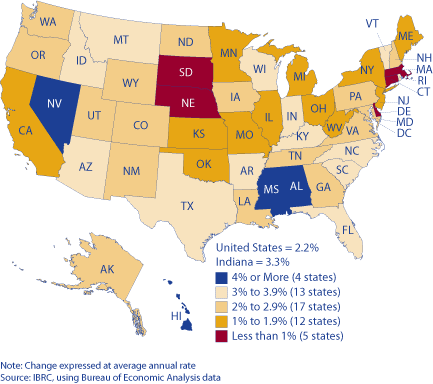
What could explain the rapid job growth but the lackluster earnings growth? A vast majority of employment growth in the professional and business services sector is attributed to the administrative and waste services industry. This industry consists of temporary services, landscaping, janitorial services, security guards and the like. These positions pay less on average than jobs like lawyers, management consultants and research and development scientists that fall in the category of professional and technical services. The national average earnings per job for professional and technical services is about $50,000 while average earnings per job for administrative and waste services is around $25,000. The differential for Indiana is not as dramatic, but it is significant, $34,000 vs. $21,000.
Figure 6 presents average earnings per job by industry for Indiana, the Midwest and the nation. Only in manufacturing are earnings per job greater in Indiana than the national average and the Midwest. Fortunately, the rates of change in earnings for several sectors are greater in Indiana than in the nation or Midwest. Given the low rates of earnings growth, compensation in the professional and business service sector and the finance, insurance and real estate sector will remain chronically below the national and Midwestern average. In addition, earnings growth in Indiana in those sectors fell short of the changes in the consumer price index.
Figure 6: Average Compensation by Industry in Current Dollars, 2005
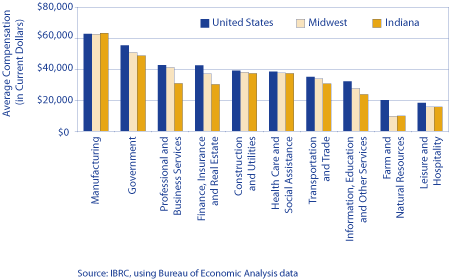
The U.S. economy has been transitioning from a manufacturing-dominated to a service-dominated economy since World War II. In the last couple decades, the pace of that transformation has increased. As a result, the dynamics of employment in the service industries is increasingly important. Only in administrative and waste services is Indiana's rate of job growth significantly greater than the U.S. average. In wholesale and retail trade, and in finance and insurance, the nation has been adding jobs while Indiana has been experiencing job losses. Both the nation and Indiana lost jobs in the information industry. In this singular case, however, Indiana's rate of employment loss is lower than the national average.
As noted above, for any particular industry, there can be dramatic differences in the level of earnings per job across geographic regions. As a result, one can expect that there would also be considerable differences in personal income between regions and states. In early August, the Commerce Department released per capita personal income for 2006 based on metropolitan statistical areas (MSAs). (1) Excluding the Gary metro division that is part of the Chicago MSA, Indiana has 15 MSAs, several of which are shared by adjoining states.
Figure 7 shows that no Indiana MSA has a per capita personal income greater than the national average for metropolitan areas. The larger MSAs in Indiana also lag behind the national average in per capita personal income growth.
Figure 7: PCPI and Change at Average Annual Rate, 2001 to 2006

In broad strokes, the MSAs with employment growth are also gaining population. In the case of Elkhart-Goshen, job growth is almost twice the rate of population growth. Not surprisingly, U.S. population and employment growth track each other in lock-step. For smaller regions, however, there can be significant differences as large employers open or close plants and residents make decisions in response to economic incentives and opportunities.
One of the fastest growing employment categories in the country is that for proprietors. While employment growth nationwide registered about 1.1 percent, proprietor employment increased by 4.5 percent from 2001 to 2005. (2005 is the last year for which there is complete data for proprietor income on a statewide basis.) For the entire state of Indiana, proprietor employment contributed significantly to job growth, adding over 66,000 jobs from 2001 to 2005, but the rate of growth was more moderate than the national average, 2.8 percent over the same period.
The picture doesn't change much through 2006 on an MSA basis. Data for proprietor employment and income show that all Indiana MSAs grew more slowly than the national metropolitan trend. Proprietor employment also grew more significantly in the larger metropolitan areas in, or adjoining, the state. While job growth may not be keeping pace with the national average, compensation growth has. According to Figure 8, proprietor income is growing more quickly than the national average in every Indiana-related MSA except Kokomo and Fort Wayne. While Indiana MSA income growth rates for proprietors are better than the national metropolitan average as a general rule, only a handful of MSAs beat the U.S. income average—South Bend, Anderson, Indianapolis and Evansville. Another handful of Indiana MSAs report an average proprietor income of less than half the national average.
Figure 8: Proprietors Employment and Income by MSA, 2001 to 2006
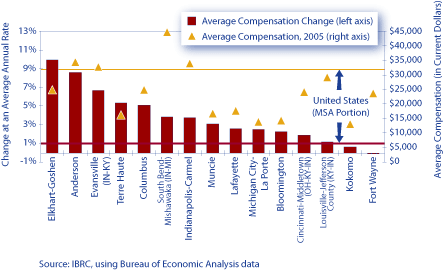
What conclusions can be drawn from all these data? Given the greater reward from a job in manufacturing as opposed to a job in the hospitality and leisure sector, one can see why there is such a desire to maintain Indiana's manufacturing base. Whether policy makers and economic development proponents can forestall further erosion in manufacturing employment is an open question. Indiana has not kept pace with its peers in expanding employment opportunities in faster-growing, higher-wage service industries. Clearly, the restructuring of the Indiana economy from high-wage manufacturing to the high-wage service industries like professional and technical services has lagged. Without an acceleration in growth in employment and income in the dynamic service sectors that are growing elsewhere, Indiana could fall further behind national averages in earnings per job and per capita personal income.
Note
- Personal income and per capita personal income estimates for the 363 metropolitan areas for 2006 were released on August 7, 2007. Indiana also shares the Chicago MSA but it was not included in this analysis because Indiana's contribution to the MSA is overwhelmed by Chicago.
Timothy F. Slaper
Director of Economic Analysis, Indiana Business Research Center, Kelley School of Business, Indiana University
